 The Nose Knows
The Nose Knows What Makes Fizzy Drinks Fizzy?
What Makes Fizzy Drinks Fizzy?
 The Gooey Science of Melting Cheese
The Gooey Science of Melting Cheese
 The Science of Stretchy Cheese
The Science of Stretchy Cheese
 Awesome Avocados and Amazing Acids
Awesome Avocados and Amazing Acids
 Design Challenge: Keep Your Cool
Design Challenge: Keep Your Cool
 How to Make the Best Whipped Cream Ever
How to Make the Best Whipped Cream Ever
 = Activity
= Activity  = Experiment
= Experiment


 TOTAL TIME 10 minutes
TOTAL TIME 10 minutes
Does what you smell change what you taste? Find out with this supereasy taste test. Jelly Belly jelly beans have very intense flavors and work the best in this experiment.
Materials
1 bag Jelly Belly jelly beans
1 small bowl
1 blindfold per taster (optional)
 Get Started!
Get Started!
1 Empty bag of jelly beans into bowl.
2 Make a prediction: Do you think a jelly bean’s flavor changes if you hold your nose while you eat it? Why or why not?
3 Close your eyes or put on your blindfold—no peeking! With 2 fingers, pinch your nose closed.
Read through the rest of the steps before you close your eyes!
4 Keep pinching your nose. With your other hand, pick up 1 jelly bean. Put it in your mouth. Chew it while you slowly count to 3 in your head. Can you tell what flavor it is? What does it taste like?
5 Observe your results: Let go of your nose. Breathe in and out as you chew the jelly bean. Slowly count to 3 in your head again. Swallow the jelly bean. Is the taste different when you let go of your nose? How so? Can you tell what flavor the jelly bean is?
6 Repeat with more jelly beans. If you’re doing this experiment with friends, take turns picking out jelly beans for others to taste and guess the flavor (only the picker should be able to see the jelly beans). How often can tasters correctly identify the jelly bean’s flavor when they’re holding their noses? How about when they let go?
Fun Fact!
Did you ever notice that when you have a stuffy nose, a lot of foods just taste kind of, well, blah? That’s because your stuffy nose prevents some air from moving through your nose, which limits your retronasal olfaction (see below!).
 UNDERSTANDING YOUR RESULTS
UNDERSTANDING YOUR RESULTS
Don’t read until you’ve finished the experiment!
Could you tell the flavor of your jelly bean when you were pinching your nose? We did this experiment in the America’s Test Kitchen Kids lab and every single person had trouble identifying the jelly bean flavors when they held their noses. “It just tastes sweet, like sugar,” said one taster. But as soon as they let go of their noses, all the tasters could immediately tell what flavor jelly bean they were eating. Is this what you observed, too?
So what’s going on? Why do jelly beans have ZERO flavor when you hold your nose and then a ton of flavor when you can breathe in and out? First, we need to break down the difference between taste and flavor. They’re actually not the same thing. (Surprise!)
We get the taste of a food from the tastebuds in our mouth and on our tongue. They tell you if something is sweet, sour, salty, bitter, or umami (which is a meaty, savory taste). When you chewed the jelly bean with your nose closed, your tastebuds detected that it was sweet, since jelly beans contain a lot of sugar.
But there’s more going on here. When you’re chewing, you’re also breathing in and out through your nose. When you breathe out, the smell of whatever you’re chewing flows from your mouth up into your nose. The smell gets to your nose through a passage at the back of your mouth. This way of smelling is known as retronasal olfaction (“ret-tro-NAY-zal ol-FACK-shun”). Say that five times fast. (You also can detect smells when you breathe in through your nose—this is just called olfaction. Not quite as fun to say.)
When you let go of your nose and chewed the jelly bean, its smell traveled up into your nose. Suddenly, your brain could put together what your nose knew and what your tastebuds tasted, and ta-da! You figured out the flavor of the jelly bean!
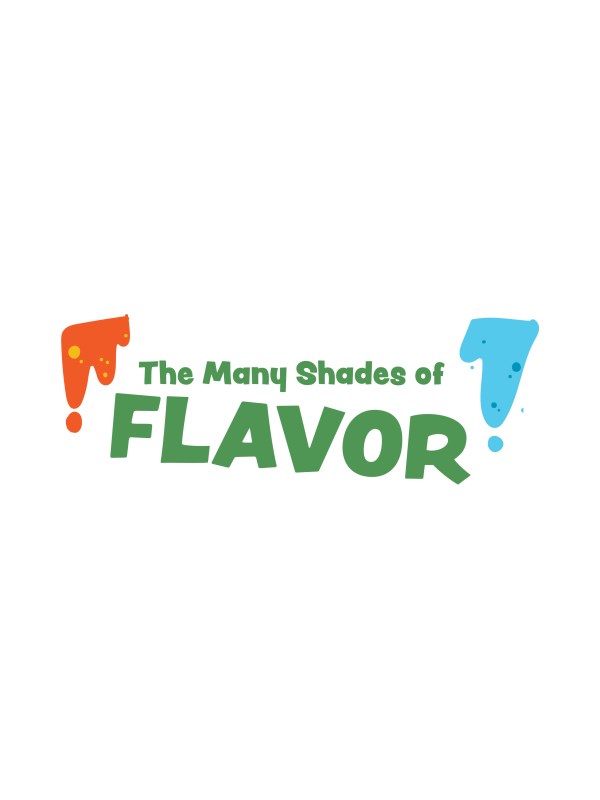

 TOTAL TIME 20 minutes
TOTAL TIME 20 minutes
In this activity, YOU are the scientist! Your research question? Does a food’s color affect what we think of its flavor? To answer this question, you’ll have unsuspecting “subjects” (your friends and family) taste two different samples of apple juice—one plain and one that you dyed red with (flavorless) food coloring. Shhh! Don’t give it away!
Materials
½ cup apple juice per taster
Red food coloring (liquid, not gel)
2 small, clear drinking glasses per taster
Masking tape or sticky notes
Marker or pen
Liquid measuring cup
Spoon
1 piece of scrap paper per taster
1 pen or pencil per taster
 Get Started!
Get Started!
1 Figure out how many subjects you will have for your experiment. (When scientists are conducting research, their “subjects” are the people whose reactions or responses they’re studying.) You can tell your subjects that you’re looking for their opinions on some samples of juice. Don’t tell them anything else about the experiment at this point! You don’t want to sway their thoughts.
2 In a separate room (or somewhere your subjects can’t see you), prepare a set of juice samples for each subject. Use masking tape and marker to label 1 glass as “A” and 1 glass as “B.” Add ¼ cup of apple juice to glass A. Add another ¼ cup of apple juice to glass B.
3 Add 5 to 8 drops of red food coloring to all the glasses labeled “A.” Use spoon to stir each glass until color is evenly distributed. You want your juice to look bright red—think fruit punch or cranberry juice. (Working with food coloring can stain your hands, so you might want to wear gloves for this part of the experiment.)
4 Set up your experiment on a table or counter. Create a spot for each of your subjects with 1 glass of sample A, 1 glass of sample B, 1 piece of scrap paper, and 1 pen or pencil.
5 Make a prediction: Do you think your subjects will think the two glasses of juice will taste the same or different? Why do you think so?
6 Call in your subjects! Have each of them sit or stand at 1 of the spots you set up. Explain what they need to do; you could say something like this:
• You have 2 samples of juice in front of you, sample A and sample B.
• Take a few sips of each sample and think about their flavors. Do they taste sweet? Sour? Bitter? Does the flavor remind you of anything? Which sample do you like better, A or B?
• You can jot down notes on the scrap paper at your spot. Don’t say anything out loud about the samples until everyone is ready! You don’t want to influence others’ opinions.

7 Observe your results: Once all subjects have finished tasting and thinking, ask them to tell you what they thought of each sample’s flavor. Have subjects vote for which juice they preferred, A or B, by a show of hands.
8 Time for the big reveal! Tell your subjects that you played a (small) trick on them—in the name of science! The juice in samples A and B was the same—both glasses contained apple juice, but sample A was dyed red. Were your subjects surprised?
9 Ask them to taste the 2 juice samples again, this time with their eyes closed. What do they think of the flavor of the samples now? Do they taste the same? Do they still taste different?
 UNDERSTANDING YOUR RESULTS
UNDERSTANDING YOUR RESULTS
Don’t read until you’ve finished the experiment!
How many of your subjects believed that these were two different juices? When we tried this experiment in the America’s Test Kitchen Kids lab, NONE of our subjects realized that both glasses contained apple juice. Everyone thought they were two different kinds of juice! Some of our subjects thought the red juice might be strawberry, cherry, or fruit punch flavor. A few did identify the plain (non-dyed) juice as apple juice.
Why was it so easy to trick our subjects into believing they were tasting two different juices, just by changing the color? Scientists have been investigating this question for more than 50 years, and they still don’t have all the answers—maybe you’ll figure some of them out!
Here’s some of what we DO know: As we grow up and taste lots of different foods and drinks, our brains come to associate certain flavors with certain colors. We connect yellow with lemon, green with lime, red with strawberry or cherry, and blue with…blue flavor? You get the picture. And those connections are really strong. When we see a drink that’s red, our brain already starts to think, “That’s probably strawberry, or cherry, or cranberry,” even before we take a sip. When we taste a food or drink that’s the “wrong” color, such as apple juice that’s been dyed red, our brains have a hard time ignoring the color and using taste and smell to identify flavor.
An extreme example of how food’s color affects what we taste came from a study in which researchers served people a dinner of steak, french fries, and peas. Delicious, right? The only strange thing was that the subjects were eating dinner pretty much in the dark. Then, partway through dinner, the researchers turned up the lights. The subjects saw that the steak had been dyed blue, the french fries dyed green, and the peas dyed red. Let’s just say that many of them suddenly felt very sick, even though the food was perfectly fine—and tasted delectable just moments before. Behold the power of color.
Take It Further
Want to do some more experimenting with color and flavor? Try serving subjects vanilla pudding alongside vanilla pudding that you dyed brown (use gel food coloring here)—do your subjects think the brown pudding is chocolate-flavored? Or try dying lemon-lime soda with orange food coloring—do your subjects think it’s orange soda? What other foods can you think of to try this with? Use the space below to record what other foods you tried this with—and your results.


 TOTAL TIME 10 minutes
TOTAL TIME 10 minutes
Have you ever noticed that the bubbles only appear in a fizzy bottle of soda or seltzer AFTER you open the bottle? In this experiment, you’ll discover the origins of those bouncing bubbles.
Materials
3 cups (24 ounces) plain seltzer, chilled
2 raisins or dried cranberries
2 tall, clear drinking glasses, both the same size and shape
1 clean marble or ball bearing
Spoon

 Get Started!
Get Started!
1 Make a prediction: Which do you think will create more bubbles: Dropping a raisin or dropping a marble into a glass of seltzer? Why do you think so?
2 Fill both drinking glasses with cold seltzer until they are about ¾ full (be sure to fill both glasses to the same level).
3 Place glasses side by side on counter. Hold marble about 1 inch above surface of seltzer in 1 glass. Hold raisin about 1 inch above surface of seltzer in second glass (make sure marble and raisin are at same height).
4 Observe your results: Let go of marble and raisin at same time, letting them drop into their respective glasses. Observe what happens for 30 seconds.
5 Use spoon to retrieve marble and raisin from the glasses. Repeat steps 3 and 4 with marble and second raisin. This time, observe what happens for at least 5 minutes. How do your results compare with your prediction?
 UNDERSTANDING YOUR RESULTS
UNDERSTANDING YOUR RESULTS
Don’t read until you’ve finished the experiment!
The bubbles in seltzer or soda are made of carbon dioxide gas. When seltzer is in a sealed bottle, the gas is dissolved in the liquid—you can’t see it. When you open the bottle, some of the dissolved carbon dioxide turns back into a gas and escapes as bubbles. But to get the bubbles really popping, you need help.
Just like Clark Kent needs a phone booth to change into Superman, dissolved carbon dioxide needs a special place to become a bubble, called a nucleation (“new-clee-AY-shun”) site. Bubbles form at nucleation sites and rise through the beverage until they pop at the surface. A nucleation site can be anything from a tiny fiber from a towel to the surfaces of the marble and raisin.
The wrinkly raisin has more nucleation sites than the smooth marble. And more nucleation sites means more bubbles! But there’s only so much carbon dioxide dissolved in the water. Eventually, the bubbles slow down because there’s not much carbon dioxide left. The gas is used up more quickly when there are more nucleation sites, as in the glass with the raisin.


 TOTAL TIME 25 minutes
TOTAL TIME 25 minutes
Salt doesn’t just make foods tastier—it can also help create colorful works of art! The number of bowls you need depends on your type of watercolor paints. For dry pans of paint, you’ll need two bowls, one for the salt and one for water. For liquid watercolor paints, you’ll need one bowl for salt, one bowl for water, and one bowl for each color paint.
Materials
Pencil
Watercolor paper or card stock
Rimmed baking sheet
White glue
1 cup kosher salt
2 (or more) small bowls
Small paintbrush
Watercolor paints
Water
 Get Started!
Get Started!
1 Decide on your design: Will you create a picture of something (or someone), or an interesting pattern? Use pencil to sketch or trace an outline of your design on watercolor paper.
2 Place paper inside rimmed baking sheet. Carefully squeeze white glue from bottle over your pencil outline—add glue wherever you want there to be color on your design.
3 Add salt to 1 small bowl. Use your fingers to generously sprinkle salt all over glue (paint won’t stick to any spots of glue not covered in salt).
4 Carefully pick up paper and gently shake off excess salt onto baking sheet. Let glue dry for 5 minutes. Ask an adult to help you pour excess salt back into bowl. (Reuse the remaining salt to create another artwork, but do not use it for cooking or eating.)
5 Load paintbrush with paint. Gently touch paintbrush to salt to add color. Don’t swipe or move paintbrush— the paint will naturally travel along salt-covered outlines of your design.
6 Continue loading paintbrush with paint and touching paintbrush to salt. If you want to switch colors, be sure to thoroughly rinse paintbrush in water before dipping it in new color of paint.
7 After you’ve finished adding color to your design, set aside paper where it won’t be disturbed. Let dry for at least 2 hours. Then, display your artwork!
Food for Thought
Why does the watercolor paint color the salt, but not the paper below? It’s all thanks to the special relationship between salt and water. Salt is hygroscopic (“hi-grow-SKAH-pick”). That means it’s REALLY good at absorbing water from its surroundings. Don’t believe us? Try dripping some water onto the extra salt left over from making your salt art. The salt should absorb the water almost instantly.
Watercolor paint is made of mostly—you guessed it—water! When you touch the salt with the watercolor paint, the salt, like a sponge, quickly absorbs the paint. There’s no paint left over to reach the paper below.
Fill in the Gaps
Here’s another way to use salt and watercolor paint to make art! Use your paintbrush to paint a large area on a sheet of watercolor paper, making sure to use plenty of water. While the paint is still wet, sprinkle a little kosher salt onto the paint, and then observe. The salt will create a pretty pattern as it absorbs the water in the paint!



 MAKES About 1 tablespoon flaky salt
MAKES About 1 tablespoon flaky salt
TOTAL TIME 10 minutes, plus 24–48 hours evaporation time
Humans have been harvesting salt since prehistoric times. Try it yourself by creating a model ocean and harvesting your own chunky, flaky salt! Tap water can contain tiny dissolved minerals that are safe to drink but can give your salt a bitter flavor.
Materials
¼ cup distilled or filtered water
2 tablespoons kosher salt
Liquid measuring cup
Oven mitts
1-teaspoon measuring spoon
Spoon
Coffee filter
8-inch square glass baking dish or pie plate
Hand lens (optional)
 Get Started!
Get Started!
1 Add water to liquid measuring cup. Heat in microwave until water is steaming, 1 to 1½ minutes. Use oven mitts to remove measuring cup from microwave (ask an adult for help).
2 Add 1 teaspoon of salt to hot water. Stir with spoon until salt is completely dissolved and water is clear. Continue adding salt, 1 teaspoon at a time, and stirring until all salt is dissolved into water. If there are undissolved salt crystals after you’ve added all the salt, strain solution through coffee filter before continuing with step 3.

3 Set baking dish in place where it won’t be disturbed. (A warm, sunny spot will help speed up evaporation.) Carefully pour saltwater into baking dish—this is your model of the ocean.
4 Leave baking dish undisturbed for 24 to 48 hours, or until all water has evaporated. Use hand lens, if you have one, to observe model ocean a few times as it evaporates. What do you notice?
5 Harvest your salt! Use spoon to gently scrape salt from bottom of baking dish (salt will form large chunks). Salt can be stored in airtight container indefinitely.
Food for Thought
The big square or rectangular salt crystals you harvested actually came from the tiny crystals of kosher salt you started with! When you dissolve salt in hot water and then let the water slowly cool and evaporate, the structure of the salt crystals left behind can change.
When mixed with water, salt crystals dissolve into tiny ions. The hotter the water, the more salt you can dissolve into it. When dissolved salt ions find one another, they lock together (kind of like puzzle pieces) and fall out of the solution. As more salt joins them, the crystal grows bigger and bigger. The slower a salt solution cools, the more time the salt ions have to find one another and grow larger crystals. Since you let your salt solution cool slowly, you were able to form some big salt crystals!
This flaky, chunky salt is great for sprinkling on finished dishes, such as eggs, vegetables, fruits, meats, and more. Check out the Make It Your Way Challenge: Get Salty (this page) and discover what foods taste better with a sprinkle of salt!


 MAKES About 1 cup salsa
MAKES About 1 cup salsa
TOTAL TIME 30 minutes
YOU get to be the scientist in this edible experiment! Your research question: Does changing the texture of a food also change its flavor? Recruit a few volunteers (and make some tasty salsa) to help you find out.
Materials
1 (14.5-ounce) can diced tomatoes, opened
2 slices jarred pickled jalapeño
2 teaspoons lime juice, squeezed from ½ lime
1 garlic clove, peeled
¼ teaspoon salt
¼ cup fresh cilantro leaves
Tortilla chips (optional)
Fine-mesh strainer
3 bowls (1 medium, 2 small)
Rubber spatula
Food processor
Masking tape or sticky notes
Marker
1 blindfold per taster
2 spoons per taster
1 glass of water per taster
 Get Started!
Get Started!
PART 1: MAKE YOUR SALSA SAMPLES
1 Set fine-mesh strainer over medium bowl. Pour tomatoes into fine-mesh strainer. Use rubber spatula to stir and press on tomatoes to remove liquid. Let tomatoes drain in strainer for 5 minutes. Discard liquid.
2 Place jalapeño, lime juice, garlic, and salt in food processor. Lock lid into place. Hold down pulse button for 1 second, then release. Repeat until ingredients are roughly chopped, about five 1-second pulses. Remove lid and use rubber spatula to scrape down sides of bowl.
3 Add drained tomatoes to mixture in food processor. Lock lid back into place. Hold down pulse button for 1 second, then release. Repeat until evenly chopped, about three 1-second pulses. Remove lid and carefully remove processor blade (ask an adult for help). Add cilantro to processor and use rubber spatula to stir to combine.
4 Transfer half of salsa to 1 small bowl. Use masking tape and marker to label bowl “Sample A.” Set aside.
5 Use rubber spatula to scrape down sides of processor bowl. Replace processor blade (ask an adult for help). Lock lid back into place. Turn on processor and process for about 30 seconds. Stop processor, remove lid, and use rubber spatula to scrape down sides of bowl. Lock lid back into place, turn on processor, and process for another 30 seconds, or until salsa is very smooth.
6 Remove lid and carefully remove processor blade (ask an adult for help). Transfer salsa to second small bowl. Use masking tape and marker to label bowl “Sample B.” Set aside, making sure both bowls are out of tasters’ sight.
7 Make a prediction: Do you think the two salsa samples will taste the same or different? Why do you think so?
PART 2: CONDUCT YOUR EXPERIMENT
1 Recruit some tasters. Explain that they are going to taste 2 different salsas. Their job is to think about the flavor and texture of each salsa.
2 Tell tasters to put on their blindfolds. Give each taster a spoonful of Sample A to eat. Tasters should chew slowly, thinking about the sample’s flavor and texture, but should keep their thoughts to themselves for now.
3 Give each taster a glass of water and have them take a sip. Then, give each taster a spoonful of Sample B to eat. If tasters would like, give them more spoonfuls of each salsa to taste.

4 Observe your results: Put the 2 salsa samples out of tasters’ sight. Have tasters remove their blindfolds. Ask tasters to share what they thought of the texture and flavor of each sample. Could they identify any of the ingredients in either sample?
5 Show tasters the bowls of salsa. Explain that both samples contained the exact same ingredients. The only difference? Their texture. Did tasters think Sample A and Sample B had the same flavor? Could they identify any ingredients in the salsas? (Snack on the rest of your salsa with some tortilla chips!)
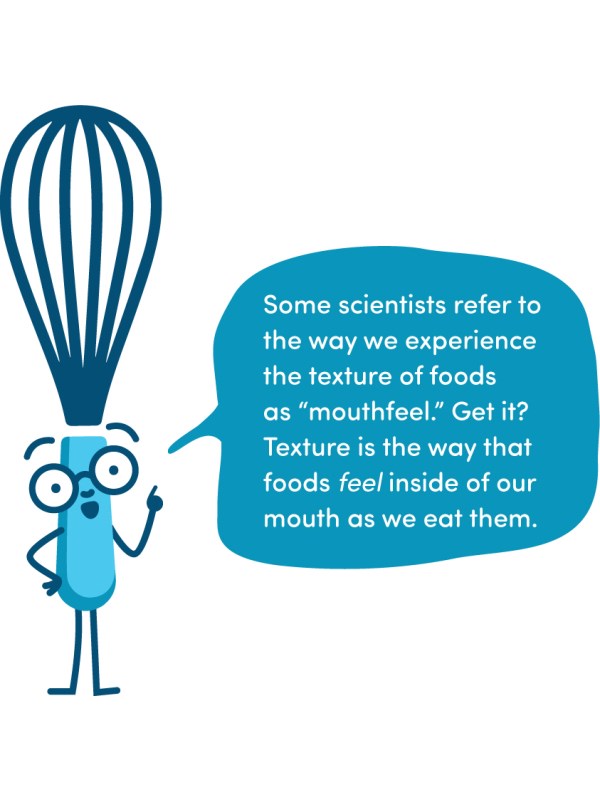
 UNDERSTANDING YOUR RESULTS
UNDERSTANDING YOUR RESULTS
Don’t read until you’ve finished the experiment!
When we talk about the flavor of food, we’re usually referring to a combination of its taste and its smell. But the way food feels in your mouth as you eat it—its texture—plays a big part in our eating experience.
Were your tasters able to identify the ingredients in the chunky salsa? How about in the smooth salsa? Did they think the two samples tasted similar or different? It’s often easier to pick out the distinctive flavor and texture of individual ingredients, such as the soft tomato and leafy cilantro, in the chunky salsa. In the smooth salsa, all of the ingredients were processed into tiny pieces, so everything has a similar texture. When you take a bite of smooth salsa, you experience the flavors of lots of ingredients at once, rather than larger pieces of just one or two ingredients.
What happens if you change the iconic texture of a food? Is it as easy to identify what you’re eating? See for yourself!
What You’ll Need for 4 Tasters
½ cup plus ¼ cup Rice Krispies cereal, measured separately
½ cup plus ¼ cup milk, measured separately
Blender
Dish towel
1-tablespoon measuring spoon
1 blindfold per taster
2 small bowls per taster
1 spoon per taster
 Get Started!
Get Started!
1 Place ½ cup Rice Krispies and ½ cup milk in blender. Place lid on top of blender and hold lid firmly in place with folded dish towel. Blend until smooth, about 10 seconds.
2 Prepare 2 samples for each taster: Scoop 2 tablespoons of the blended Rice Krispies–milk mixture into 1 small bowl. In second small bowl, combine 1 tablespoon Rice Krispies and 1 tablespoon milk. (Make sure tasters don’t see what you’re doing!)
3 Have tasters put on blindfolds. Give tasters blended Rice Krispies–milk mixture and a spoon. As they eat, ask tasters to guess what they are eating—but keep their ideas to themselves for now! Repeat with samples of whole Rice Krispies and milk.
4 Have tasters remove their blindfolds. Ask what they thought about each sample—could they identify what they were eating? Then, tell tasters exactly what they were eating!
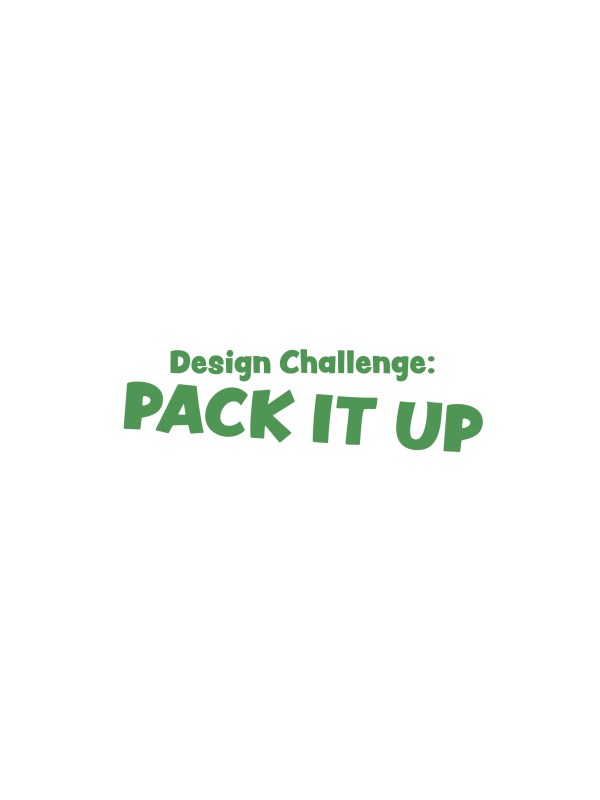

 TOTAL TIME 25 minutes
TOTAL TIME 25 minutes
Your challenge? Design a package that will protect a single potato chip or cracker from breaking during a fall.
Materials
2–3 Pringles potato crisps, saltines, water crackers, or other thin, fragile chips or crackers
You can use the materials on this list to create your design, or any other supplies around your house! Cotton balls • Tissue paper • Aluminum foil • Craft sticks • Scrap paper • Tape • Cardboard • Fabric scraps • Brown paper lunch bags • Empty egg carton • Ruler or tape measure • Scissors
 Get Started!
Get Started!
1 Your challenge is to design a package for a single potato chip or cracker. Your chip package must:
• Protect the chip from breaking if your package falls onto the floor
• Include a way to put the chip into the package and take it out again, such as a flap, a door, or a latch
• Be smaller than 6 inches in all directions
2 Gather information: Look at food packages in your pantry, refrigerator, and freezer, such as egg cartons, cereal boxes, and juice boxes. Which ones protect something fragile inside? How do they do it?
3 Brainstorm your design: What materials will you use? Think about what properties might help protect your chip. Do you want to use something flexible? Soft? Thin? Thick? Think about different ways you can use a material. For example, you can roll, fold, or crumple paper.
4 Build your design: Once you have come up with an idea and decided what materials you will use, it’s time to build your design. Keep in mind:
• How will you get your chip into and out of your design?
• Make sure the chip will fit inside your design. (Hint: Use a ruler!)
5 Test your design: Use a ruler to check that your package isn’t bigger than 6 inches in any direction. If it is, tweak your design to make it smaller. Use a ruler to measure 4 feet above a hard surface, such as a wood or tile floor. Hold your package at the 4-foot mark and drop it onto the ground. Repeat this 2 more times.
6 Observe your results: Open your package and remove your chip. How easy was it to open your package and remove your chip? Is it still in one piece? (Don’t worry if your chip broke! When engineers design new technologies, their projects almost never work the first time! They think about what worked—and what didn’t work—and then they try again.)
7 Redesign your chip package to make it even better and test it again. What will you change?
Food for Thought
The next time you go to the grocery store, take a closer look at all the different types of food packages. What do you notice? Can you find packages that keep food fresh? How about packages that help you dispense just the right amount of an ingredient? Packages designed to help you eat out of them? What else do you see?

 How many different food textures can you find? Play this game with a family member or a friend the next time you’re eating together at home. You can also play on your own when you’re enjoying breakfast, lunch, a snack, or even dessert!
How many different food textures can you find? Play this game with a family member or a friend the next time you’re eating together at home. You can also play on your own when you’re enjoying breakfast, lunch, a snack, or even dessert!
Materials
1 bingo board per person
9 bingo chips per person (You can use small crackers, pretzels, candies, coins, or buttons as your “chips.”)
 How to Play
How to Play
As you’re eating, think about the different textures of your food. If you notice a texture that’s on one of your bingo-board squares, place a chip on that square. The first player to find three textures in a row—horizontally, vertically, or diagonally—wins!

Food Texture Glossary
CHUNKY Has pieces of different sizes
CREAMY Thick and rich
CRISPY Firm, dry, and delicate
CRUMBLY Falls apart easily when you bite into it
CRUNCHY Firm; sounds loud when you chew it
DRY Lacks water; feels sandy when you chew it
HARD Solid; requires effort to bite into
SMOOTH Has an even texture without lumps
STICKY Sticks to your teeth when you chew it
THICK Pours slowly, like honey


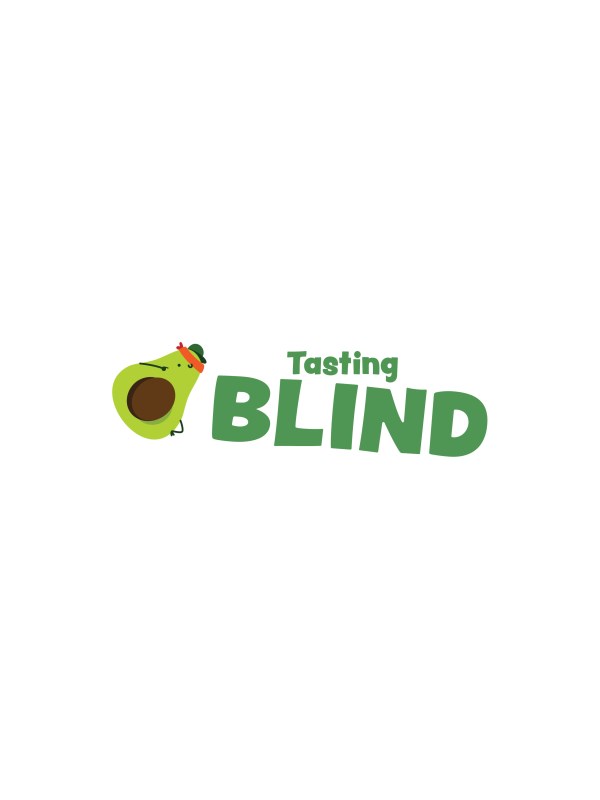

 TOTAL TIME 10 minutes
TOTAL TIME 10 minutes
Does what our food looks like affect its flavor? Find out by taking away your sense of sight as you taste two samples of cheese with one big difference—their color. Can you taste a difference if you can’t see what you’re eating? Make sure your cheeses are either both mild or both sharp cheddar. (Yellow cheddar is actually orange!)
Materials
2 slices white cheddar cheese per taster
2 slices yellow cheddar cheese per taster
1 blindfold per taster
1 small plate per taster
 Get Started!
Get Started!
1 Make a prediction: Do you think white and yellow cheddar cheese will taste the same or different? Why do you think so?
2 Choose 1 person to give out the cheese samples (this is a good job for an adult). Everyone else will be tasters. Put a small plate in front of each taster and have tasters put on their blindfolds. Tell tasters that they are going to eat 2 pieces of cheddar cheese: 1 piece is white cheddar and 1 is yellow cheddar. Can they tell which is which, if they can’t see the cheeses?
3 Once blindfolds are on, place 2 slices white cheddar cheese on left side of each small plate. Place 2 slices yellow cheddar cheese on right side of each small plate.
4 Tell tasters to pick up 1 slice of each cheese in each hand and taste it. Which do they think is the white cheddar? The yellow cheddar? Tell tasters to keep their opinions to themselves for now.
5 Observe your results: Once everyone has finished tasting, ask tasters to hold up the remaining slice of cheese that they think is the white cheddar. Then, ask tasters to hold up the remaining slice of cheese that they think is the yellow cheddar.
6 Have tasters remove their blindfolds and see if they were correct. Then, have tasters taste the remaining slices of cheese without their blindfolds on. What do they notice about the cheeses’ flavors now that they can see their colors?
 UNDERSTANDING YOUR RESULTS
UNDERSTANDING YOUR RESULTS
Don’t read until you’ve finished the experiment!
Folks in the town Cheddar, England, have been making cheddar cheese for more than 900 years. In the beginning, cheddar cheese was naturally yellow-orange because the cows’ milk it’s made from also had a yellow-orange hue, thanks to a pigment in the flavorful grass the cows ate during the warmer months. In the cooler seasons, the cow’s milk (and the cheese) was white or beige. Cheesemakers eventually realized they could conceal these differences in color by dyeing the white milk bright orange using something called annatto extract. Made from annatto seeds, the dye is completely natural—and tasteless. So, in theory, there shouldn’t be any flavor difference between the two colors of cheddar, right?
Many tasters DO detect a difference between white and yellow cheddar—though they’re usually not sure which color is which when blindfolded. If annatto is flavorless, why can many tasters detect a difference in flavor between the two cheeses?
Today, some manufacturers make their white and yellow cheddars differently. They might use milk from cows that live in different areas and eat different food, which can give their milk different flavors. One type of cheddar might contain more fat or moisture, which can change the cheese’s flavor, too.
Do you prefer white or yellow cheddar? The answer likely depends on where you live. White cheddar is more popular along the East Coast of the United States, particularly in the Northeast. The rest of the United States is definitely on team yellow cheddar.
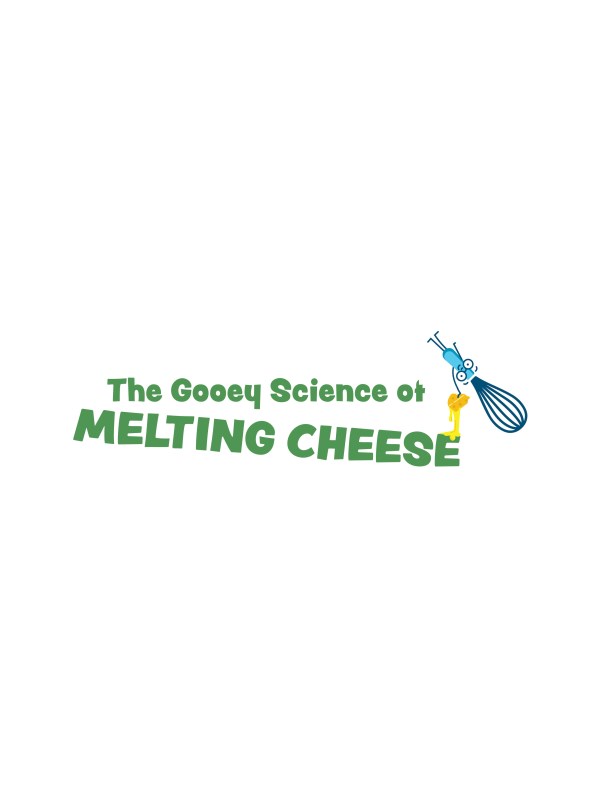


 TOTAL TIME 30 minutes
TOTAL TIME 30 minutes
Some cheese melts into gooey deliciousness, while others turn greasy, grainy, or refuse to melt at all. Find out why in this (edible!) experiment. Don’t use fresh mozzarella, mild cheddar cheese, or finely grated Parmesan cheese. You can swap the flour tortilla for corn tortillas or even small slices of bread.
Materials
1 (10- to 12-inch) flour tortilla
2 tablespoons shredded mozzarella cheese
2 tablespoons shredded sharp or extra-sharp cheddar cheese
2 tablespoons shredded Parmesan cheese
Cutting board
Chef’s knife
Rimmed baking sheet
Masking tape
Marker
Oven mitts
Cooling rack
 Get Started!
Get Started!
1 Adjust oven rack to middle position and heat oven to 200 degrees.
2 Use chef’s knife to cut tortilla into 3 equal wedges.
3 Arrange tortilla wedges on rimmed baking sheet. Sprinkle mozzarella in even layer on left tortilla wedge. Sprinkle cheddar in even layer on center tortilla wedge. Sprinkle Parmesan in even layer on right tortilla wedge.
4 Use masking tape and marker to label baking sheet “Mozzarella” by left tortilla wedge, “Cheddar” by center tortilla wedge, and “Parmesan” by right tortilla wedge.
5 Make a prediction: Do you think these 3 cheeses will melt the same way? Why do you think so?
6 Place baking sheet in oven and bake for 10 minutes.
7 Use oven mitts to remove baking sheet from oven (ask an adult for help) and place it on cooling rack.
8 Observe your results: Do the melted cheeses look the same? In what ways do they look different? Which would you choose for your grilled cheese sandwich or pizza?
9 Eat your experiment: Snack on any (or all) of your cheesy creations. What do you notice about their flavor? Their texture?
 Understanding Your Results
Understanding Your Results
Don’t read until you’ve finished the experiment!
Why does mozzarella melt into gooey perfection while Parmesan turns into a greasy mess in the oven? A lot of it has to do with the cheese’s age.
Cheese is made of a network of proteins, like lots of tiny cages, surrounding bits of fat and water. When cheese heats up, the fat turns from solid to liquid. Then its proteins loosen up, which makes the cheese “flow” like a thick liquid.
Aged cheeses contain less water than younger cheeses. As cheese ages, it loses water through evaporation (this also concentrates the cheese’s flavor). Cheeses with less water don’t melt well because their proteins cling together more tightly, making it harder for them to “flow” while also squeezing out droplets of fat.
Parmesan is the oldest of our three cheeses and it barely melts at all. Sharp cheddar is our middle-aged cheese. It melts, but it also leaks some greasy melted fat. Young cheeses—like Monterey Jack, mild cheddar, and mozzarella, which isn’t aged at all—are the best choices if you’re looking for smooth melted cheese.
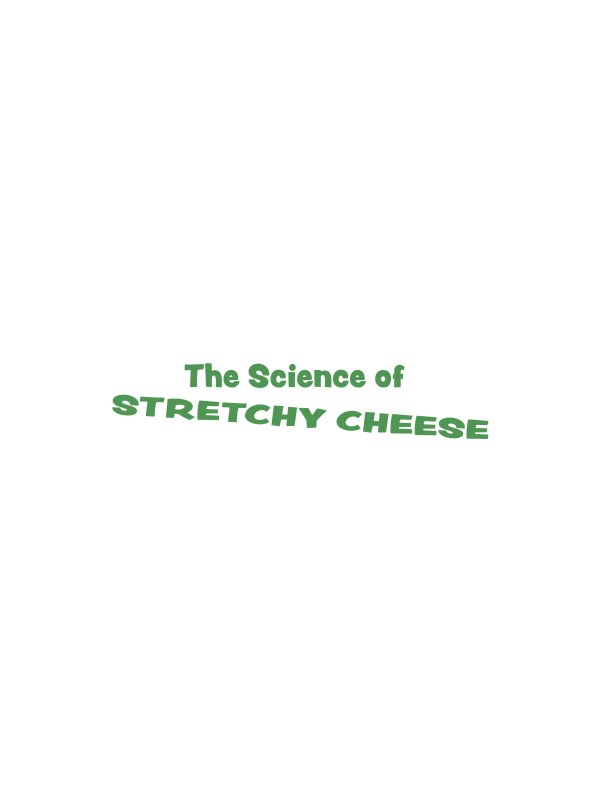

 MAKES 2 grilled cheese sandwiches
MAKES 2 grilled cheese sandwiches
TOTAL TIME 25 minutes
Some cheeses stretch. Others don’t. Stretch your mind as you test cheese stretchability in this edible experiment! Don’t use low-fat or preshredded cheese here. You can swap Monterey Jack, Swiss, or even mild or sharp cheddar for the extra-sharp cheddar.
Materials
4 slices hearty white or wheat sandwich bread
½ cup shredded extra-sharp cheddar cheese
½ cup shredded mozzarella cheese
2 tablespoons unsalted butter
Cutting board
12-inch nonstick skillet
Spatula
Ruler
 Get Started!
Get Started!
1 Place bread slices on cutting board. Sprinkle cheddar evenly over 1 slice of bread. Sprinkle mozzarella evenly over second slice of bread. Place 1 bread slice on top of each sandwich and press down gently.
2 In 12-inch nonstick skillet, melt butter over medium-low heat, swirling to evenly coat skillet, about 1 minute.
3 Place sandwiches in skillet and press down on them lightly with spatula. Cook sandwiches until first side is golden brown, 3 to 5 minutes.
4 Use spatula to flip sandwiches and press lightly again. Cook until second side is golden brown and cheese is melted, about 2 minutes.
5 Turn off heat. Use spatula to transfer sandwiches back to cutting board. Let cool for 2 minutes.
6 Make a prediction: Which cheese do you think will stretch more when you pull apart your sandwiches: cheddar or mozzarella?
7 Observe your results: Use your hands to gently break cheddar sandwich in half. Hold left half of sandwich in your left hand without moving. Use your right hand to gently pull other half of sandwich to the right. Stop pulling once cheese breaks and is no longer connecting 2 halves of sandwich. How far did the cheese stretch before it broke? Use ruler to measure the length of your cheese pull.
8 Repeat test with mozzarella sandwich. How far did the cheese stretch before it broke? Use ruler to measure the length of your cheese pull.
9 Eat your experiment! Share your grilled cheese sandwiches with a friend or family member while you read about why some cheeses stretch so much more than others.
 UNDERSTANDING YOUR RESULTS
UNDERSTANDING YOUR RESULTS
Don’t read until you’ve finished the experiment!
Did your mozzarella cheese stretch much farther than the cheddar cheese?
Why is mozzarella cheese a stretchy superstar? It has a lot to do with the way it’s made. Adding acid or enzymes to milk starts the cheese-making process. It causes the milk to separate into solid curds and liquid whey. Those curds get smooshed together into solid cheese.
To make mozzarella, the curds are stretched and pulled over and over again. During that stretching, proteins in the cheese make their way into very straight lines. When mozzarella is heated, those straight lines of protein loosen up and you can pull the cheese into long strings.
Many other cheeses, such as cheddar, aren’t stretched after their curds are pressed together, so their proteins don’t form straight lines. When those cheeses melt, their proteins flow in lots of different directions, so the cheese doesn’t stretch as much as mozzarella does.


 TOTAL TIME 25 minutes, plus 1 hour observation time
TOTAL TIME 25 minutes, plus 1 hour observation time
Oil and water don’t normally mix. But look at salad dressing: in many of them, oil and vinegar (which is mostly made of water) come together to form a smooth, totally mixed combination—at least for a little while. What’s the secret? In this experiment, you’ll mix oil and vinegar on their own, with a bit of mustard, and with some mayonnaise. Mustard and mayonnaise are ingredients often found in salad dressings—could they help oil and water play nicely?
Materials
1 cup plus 2 tablespoons extra-virgin olive oil
6 tablespoons red wine vinegar
1 teaspoon Dijon mustard
1 teaspoon mayonnaise
Salt and pepper
Masking tape or sticky notes
Marker or pen
3 (6- to 8-ounce) clear jars with lids
1-tablespoon measuring spoon
 Get Started!
Get Started!
1 Use tape and marker to label 1 jar as “Control,” second jar as “Mustard,” and third jar as “Mayonnaise.”
2 Add 6 tablespoons oil and 2 tablespoons vinegar to each jar. Screw lid on jar labeled “Control.” Set jar aside.
3 Add mustard to jar labeled “Mustard.” Screw lid on tightly. Set jar aside.
4 Add mayonnaise to jar labeled “Mayonnaise” and screw lid on tightly.
5 Hold 1 jar in each hand. Vigorously shake jars for 30 seconds. Set jars aside. Repeat with remaining jar.
6 Make a prediction: In which jar do you predict the oil and vinegar will stay mixed the longest: the control jar, the mustard jar, or the mayonnaise jar? Why do you think so?
7 Observe your results: What do the jars look like right after you finish shaking them? Check on your jars every 15 minutes, until 1 hour has passed. What do you notice? Which jar kept the oil and vinegar mixed the longest? The shortest?
Eat Your Science!
Turn your emulsions into a vinaigrette salad dressing by following these steps.
1 Add contents of 1 or more jars into large airtight container with lid.
2 For each jar you combined, add ¼ teaspoon salt and ⅛ teaspoon pepper to container.
3 Cover container and shake to combine ingredients.
4 Dressing will keep in airtight container in the refrigerator for up to 1 week. Shake well before using.
 UNDERSTANDING YOUR RESULTS
UNDERSTANDING YOUR RESULTS
Don’t read until you’ve finished the experiment!
Here in the America’s Test Kitchen Kids lab, we found that the jar with mayonnaise stayed mixed the longest, with the mustard jar a close second. The jar with just oil and vinegar separated into layers after less than 15 minutes.
When you shake or whisk oil and vinegar, the two liquids form what’s called an emulsion (“ih-MUHL-shun”). Emulsion is a science word for a combination of two liquids that don’t usually mix, such as oil and water. But this emulsion won’t last long—the oil and vinegar retreat into two separate layers after just a few minutes.
To get oil and water to STAY mixed, you need some help from an emulsifier. Emulsifiers are special molecules that bridge the gap between two liquids that don’t want to get along, like oil and water. One end of an emulsifier molecule is attracted to water. The other end is attracted to oil (imagine the emulsifier is holding hands with oil on one side and water on the other). Mustard and mayonnaise both contain emulsifiers. A vinaigrette made with an emulsifier will stay combined for much longer than one made with just oil and vinegar.
So which should you use when making a vinaigrette, mustard or mayonnaise? Pick the flavor you like best! Since you add dressing to your salad soon after you mix it, either mustard or mayo works just fine.
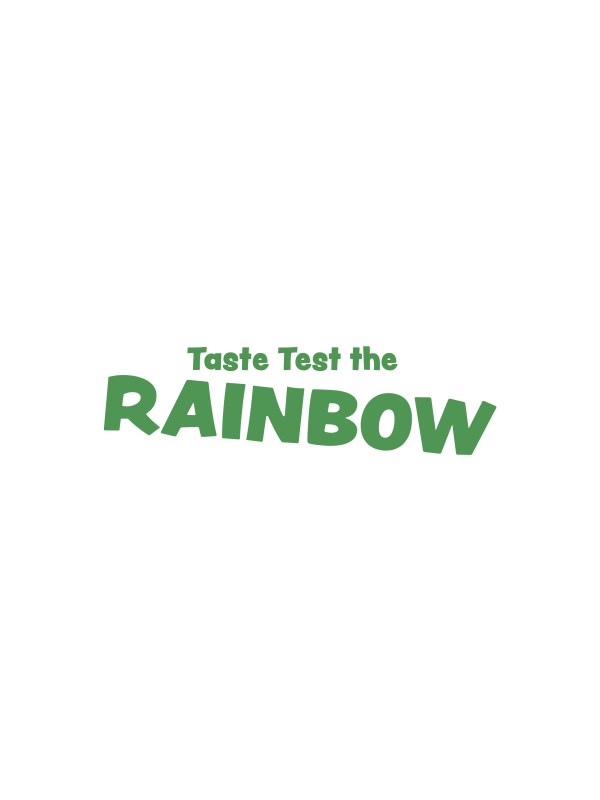

 TOTAL TIME 15 minutes
TOTAL TIME 15 minutes
Do different colors of the same vegetable taste different? Round up some family and friends and find out in this colorful taste test! (Not a fan of peppers? Not a problem! Check out Even More Science at right for other veggies you can use instead.)
Materials
1 green bell pepper, stemmed, seeded, and cut into ½-inch strips
1 red bell pepper, stemmed, seeded, and cut into ½-inch strips
1 plate per taster
1 glass of water per taster
1 blindfold per taster

 Get Started!
Get Started!
1 Make a prediction: Do you think green and red bell peppers taste the same or different? Why do you think so?
2 Choose 1 person to give out the peppers (this is a good job for an adult). Everyone else will be tasters. Give each taster a plate, a glass of water, and a blindfold. Tell tasters they are going to eat 2 pieces of bell pepper. Their job is to observe whether they taste the same or different.
3 Tasters should put on their blindfolds. Place 2 strips of green bell pepper on the left side of each plate. Place 2 strips of red bell pepper on the right side of each plate.
4 Blindfolded tasters should pick up 1 strip of pepper at a time and taste it, taking small bites and chewing slowly—but they should keep their opinions about flavors to themselves for now! They can also take sips of water between bites to give their tastebuds a break.
5 Observe your results: Once everyone has finished tasting both colors of pepper, ask tasters:
• Did you think the 2 peppers tasted the same or different? How so?
6 Have tasters remove their blindfolds. Tell tasters that they tasted two different colors of pepper: green and red. Are they surprised? Have the tasters taste each pepper again, without blindfolds. Do they detect a flavor difference now?
Even More Science Try this taste test with other vegetables that come in different colors.
• Orange carrots and purple, red, or white carrots
• Red cherry tomatoes and yellow cherry tomatoes
• Red potatoes and purple potatoes (Make sure to cook them first!)
 UNDERSTANDING YOUR RESULTS
UNDERSTANDING YOUR RESULTS
Don’t read until you’ve finished the experiment!
You might want to sit down for this: Red bell peppers are actually just grown-up green bell peppers. All peppers start out green. Then, as they ripen on the pepper plant, bell peppers change from green to either yellow or orange, and then, finally, most of them change to red. Green bell peppers are simply harvested before they are fully ripe.
Now let’s talk flavor: Green and red bell peppers taste similar, but you might have noticed some flavor differences between them. When we tasted the peppers in the America’s Test Kitchen Kids lab, tasters said the red bell peppers tasted sweeter and fruitier than green bell peppers. The flavor of green bell peppers is often described as “grassy.” These observations make sense: As peppers ripen, they create different flavor compounds, which make ripe red peppers taste a bit different from unripe green ones.
Ready for another shock? Peppers are technically fruits, not vegetables, because they contain the seeds of the pepper plant. We call them vegetables because we eat them in savory dishes.
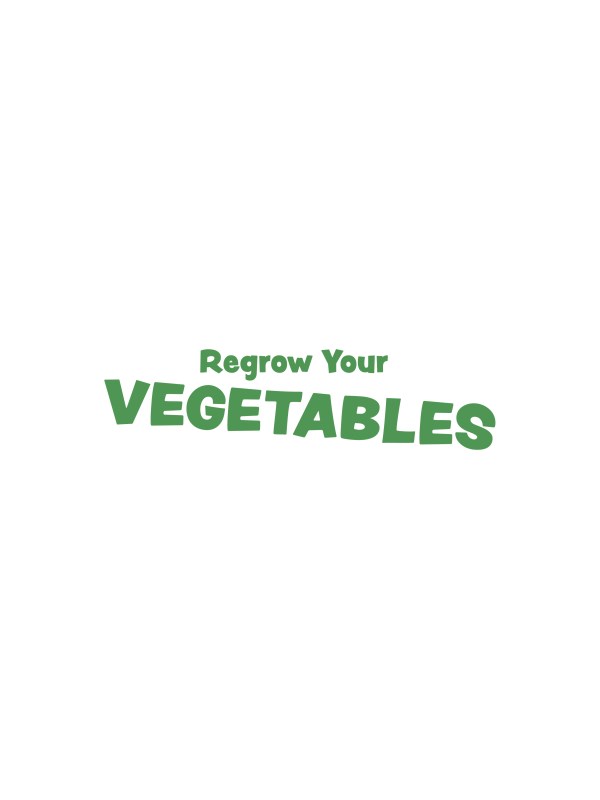

 TOTAL TIME 5 minutes, plus about 1 week growing time
TOTAL TIME 5 minutes, plus about 1 week growing time
Lots of recipes use scallions—tacos, stir-fries, lettuce wraps, and more. Next time you’re cooking, don’t toss your scallion scraps. Instead, use them to grow MORE scallions in just a week! For this activity, try to use scallions with roots that are ½ inch or longer—they will grow fastest.
Materials
Scallions
Water
Chef’s knife
Cutting board
Tall drinking glass or jar
 Get Started!
Get Started!
1 Use chef’s knife to cut off scallion greens, leaving roots, white bulb, and 2 to 3 inches light green part intact. Save scallion greens for another use.
2 Add about 2 inches water to drinking glass. Place scallion bulbs in water, root end down (top of light green part should be sticking out of water). Put glass in sunny location.
3 Every day, discard the water from glass and replace with fresh water.
4 Watch your scallions grow! When scallion greens have grown 5 to 7 inches above white and light green parts (after about 1 week), use chef’s knife to remove new scallion greens, leaving roots, white bulb, and 2 to 3 inches light green part intact. Use those scallion greens in a recipe!
5 If desired, repeat steps 2 through 4 to regrow and harvest scallion greens again. You can regrow a single scallion 2 times.

Don’t throw away leftover garlic cloves either—grow garlic greens instead! Garlic greens taste similar to chives and scallions. You can use them the same way.
Here’s how to do it:
1 Add ½ inch water to small glass or shallow container.
2 Place leftover unpeeled garlic cloves in water with root end (the flat part) facing down.
3 Replace water daily.
4 When garlic greens are 5 to 7 inches tall (after about 1 week), use chef’s knife to remove greens.

Food for Thought
Scallions, sometimes called green onions, are part of a group of vegetables called alliums (“al-ee-ums”). They’re related to garlic, onions, chives, and leeks. The white part of the scallion grows underground and stores nutrients for the rest of the plant—the light and dark green parts—that grows above ground.
The scallion roots absorb water. That water, plus energy from the sun and nutrients stored in the scallion white, helps grow a new scallion green—fast! The greens can grow as much as 1 inch per day! A scallion white contains enough nutrients to regrow scallion greens two more times before the plant runs out of fuel. Just think, you’re getting three scallions for the price of one!
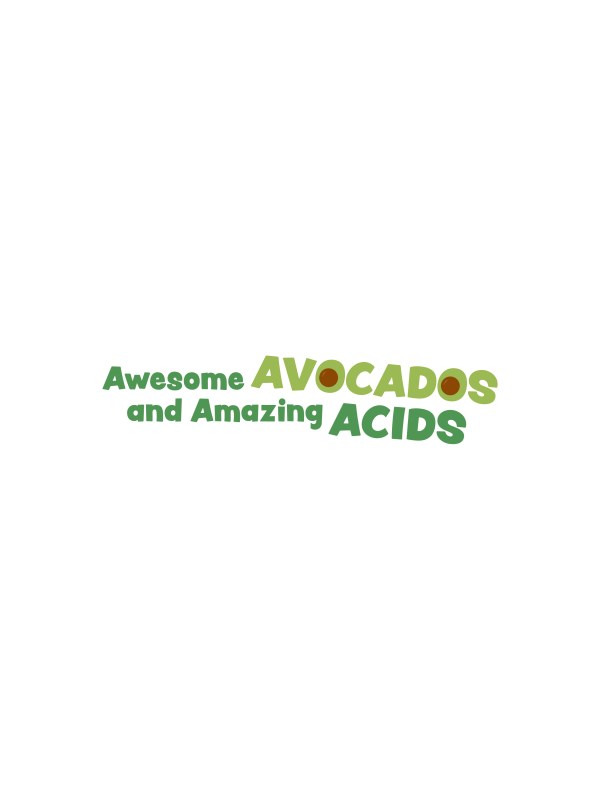

 TOTAL TIME 5 minutes, plus 8–24 hours waiting time
TOTAL TIME 5 minutes, plus 8–24 hours waiting time
Sometimes you need only part of an avocado for your taco or toast. But if you save the rest for later, your avocado will turn brown (oh no!). Can you keep it fresh and green? Find out in this easy experiment. If you don’t have a whole lemon, use 3 tablespoons of bottled lemon juice.
Materials
1 lemon
1 cup water
1 ripe avocado
Chef’s knife
Cutting board
Small bowl
Soupspoon
Small plate

 Get Started!
Get Started!
1 Use chef’s knife to cut lemon in half crosswise (not through ends). Rinse and dry knife.
2 Squeeze juice from lemon halves into small bowl. Add water to bowl.
3 Use knife to cut avocado in half lengthwise around pit. Using your hands, twist both halves in opposite directions to separate. Use soupspoon to scoop out pit. Discard pit.
4 Place 1 avocado half, cut side down, in bowl with lemon juice mixture. Place second avocado half on small plate, cut side up. Set bowl and plate in a spot where they won’t be disturbed.
5 Make a prediction: What do you think each avocado half will look like after 8 hours? Will they look the same? Different? How so?
6 Let avocado halves sit for at least 8 hours and up to 24 hours.
7 Observe your results: Turn over avocado half in lemon juice mixture. Observe the 2 avocado halves. Do they look the same? Different? What do you notice about them?
8 Eat your experiment: Both avocado halves are safe to eat—use a spoon to gently scrape off any brown parts (the flesh underneath should be green). Will you use the avocado to make guacamole or avocado toast? Will you cut it up and use it on tacos or salad?
 UNDERSTANDING YOUR RESULTS
UNDERSTANDING YOUR RESULTS
Don’t read until you’ve finished the experiment!
When you cut open an avocado, air touches the green flesh inside. After a few hours, the green avocado starts to turn brown—yuck!
Why does this happen? It comes down to chemistry: Molecules inside the avocado flesh react with oxygen in the air. That reaction, called oxidation (“ox-ih-DAY-shun”), creates new brown-colored molecules.
How can you stop cut avocados from turning brown? Acid to the rescue! Acids are found in ingredients such as lemon juice, lime juice, and vinegar. They are a kind of molecule called an antioxidant (“ann-tee-OX-ih-dent”). “Anti” means “against” and “oxi” means “oxygen,” so antioxidants are molecules that help prevent the oxidation reaction that turns avocados brown.
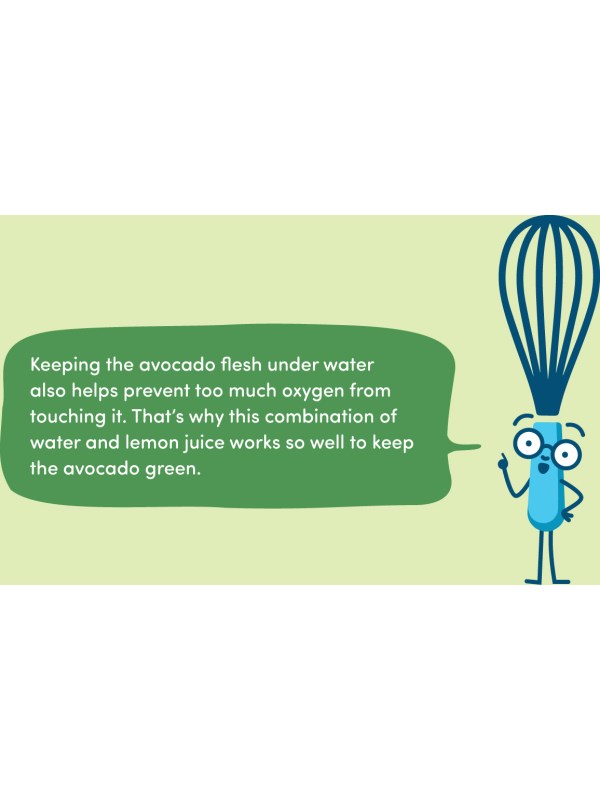
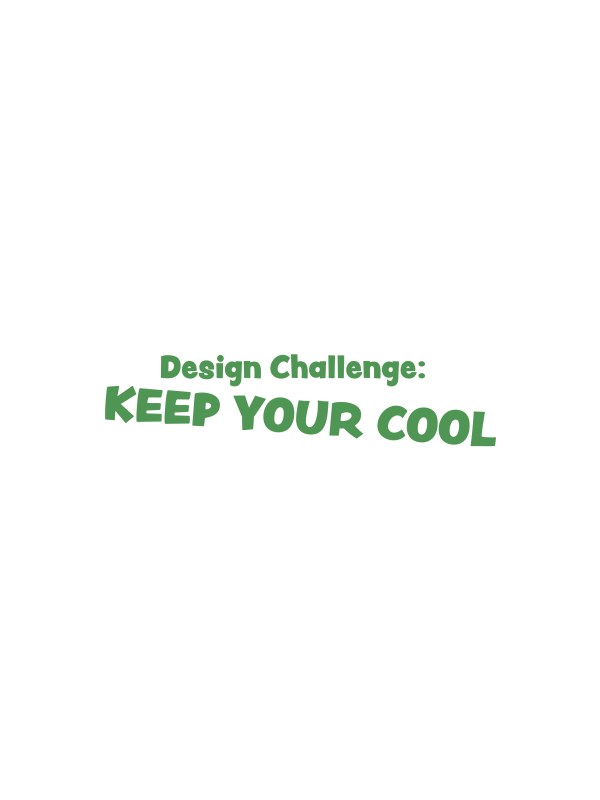

 TOTAL TIME 45 minutes
TOTAL TIME 45 minutes
On hot days, it’s important to keep food and drinks cool. Not only will they taste better, but keeping food cold also helps prevent harmful microbes from growing. Your challenge? Design a container that keeps food cold, using materials you have at home.
Materials
2 small containers with lids, both made of the same material, such as plastic containers, cardboard boxes, or jars
Scissors
2 ice cubes
Here’s a list of materials you could use for your designs, but feel free to use any supplies you have around your house! Aluminum foil • Cotton balls • Waxed paper • Scrap paper • Fabric scraps • Cardboard • String • Rubber bands • Newspaper • Paper towels • Bubble wrap • Tape • Glue

 Get Started!
Get Started!
1 Gather information: A small container will be your base. You’ll decide what materials to put inside of the container to keep it cold in there—this is known as insulation (“in-suhl-AY-shun”). After you build your design, you’ll test it by putting an ice cube inside of the container for 30 minutes and seeing how much it melts compared to an ice cube without insulation.
Think about other things you’ve seen that keep food cold on the go, such as lunch boxes, coolers, and thermoses. What properties do they have?
2 Brainstorm your design: What materials will you use for your insulation? Think about:
• Do you want a material that is thick? Thin? Fluffy? Hard?
• What are different ways you could use a material? For example, you can pull cotton balls apart into different shapes.
3 Build your design: Place your insulation materials inside 1 container, leaving room for the ice cube. Will you add any insulation to the lid of the container?
4 Test your design: Place 1 ice cube inside container with your insulation. Place second ice cube inside second container (without insulation). Cover containers with lids. Set containers aside in a warm, sunny location for 30 minutes.
5 Observe your results: After 30 minutes, remove ice cubes from both containers. Which ice cube is larger? The larger ice cube melted less—it stayed cooler. Did your design keep the ice cube cooler than the container without insulation?
Food for Thought
Ice cubes in a glass melt a lot faster than ice cubes inside a thermos or cooler. Why? The biggest difference between a glass and a thermos is insulation. Insulation is any material that slows the movement of heat—it helps keep cold things cold (and hot things hot). Heat in the air moves more slowly through the insulation in the walls of the thermos than it does through the walls of the glass, which means the ice cubes stay colder and melt more slowly inside the thermos.
Why is that? One of the best insulation materials is air. Heat moves slowly through air, especially when the air is trapped inside of another material. Think about a cozy down jacket—a layer of fluffy down between two layers of fabric. Little pockets of air trapped inside the down slow the movement of heat from your warm body into the colder surrounding air.
Materials with air trapped inside, such as foam, are often good insulators. The walls of thermoses and coolers are often made of a hard plastic shell surrounding a layer of foam insulation. But you can also trap air using other materials: Shredded, crumpled, or fluffy materials create pockets of trapped air that slow the movement of heat.
Test out different insulation materials in your design. Which ones are best at keeping the inside of the container—and the ice cube—cool?


 TOTAL TIME 5 minutes, plus 4 hours freezing time before you begin the experiment
TOTAL TIME 5 minutes, plus 4 hours freezing time before you begin the experiment
Do all frozen things feel equally cold? Melt your mind with this surprising sensory experiment.
Materials
1 ice cube
2-tablespoon cube of butter
2 zipper-lock bags
 Get Started!
Get Started!
1 At least 4 hours before you want to do this experiment, place ice cube in zipper-lock bag, seal bag (remove as much air as possible), and place bag in the freezer. Place 2-tablespoon cube of butter in second zipper-lock bag, seal bag (remove as much air as possible), and place that bag in the freezer, too.
2 Make a prediction: When you take the ice cube and butter out of the freezer and hold them in your hands:
• Will the butter feel colder than the ice cube?
• Will the ice cube feel colder than the butter?
• Will they feel the same?
3 After at least 4 hours, take bags out of freezer. Keeping them in their bags, hold ice cube in one hand and cube of frozen butter in your other hand for 15 to 30 seconds. (To make this experiment as scientific as possible, close your eyes and have an adult or a friend place one bag in each of your hands. This is called a blind test because you can’t see the samples and you don’t know which is which.)
4 Observe your results: Does one cube feel colder than the other, or do they feel the same?
 Understanding Your Results
Understanding Your Results
Don’t read until you’ve finished the experiment!
Whoa—that was weird, right? When we tried this experiment in the America’s Test Kitchen Kids lab, everyone agreed that the ice cube felt WAY colder than the frozen butter. But how can that be? The butter and the ice cube were in the same freezer, and when we measured their temperatures, they were both 3 degrees. What’s going on?
Things feel cold to us when heat is removed from our bodies. Heat always moves from warmer things, like your hand, to colder things, such as the frozen butter or ice cube. The movement of heat energy out of your body is what makes you feel cold.
But why does the ice cube (frozen water) feel colder in your hand than the frozen butter?
It’s because water needs a LOT of heat energy to warm up. Butter, which is made of about 80 percent fat and only about 15 percent water, needs much less energy to warm up the same amount. Here’s one way to think about it:
Say you and a friend each have a bucket you want to fill up with water. Your bucket is a lot bigger than your friend’s bucket, so you need a lot more water (and time!) to fill it to the top. You’re like water! Your friend, who fills up their bucket quickly, with less water, is like butter.
To get water (or ice) hot, you need to fill up a big bucket with heat energy. To get the same amount of butter to the same hotness, you need to fill up only a small bucket with heat energy.
In our experiment, that heat energy comes from your warm hands. A lot of heat energy has to move from your hand to the ice to warm it up—that makes your hand feel very cold. Warming the frozen butter takes a lot less heat energy from your hand, so your hand doesn’t feel quite as cold.
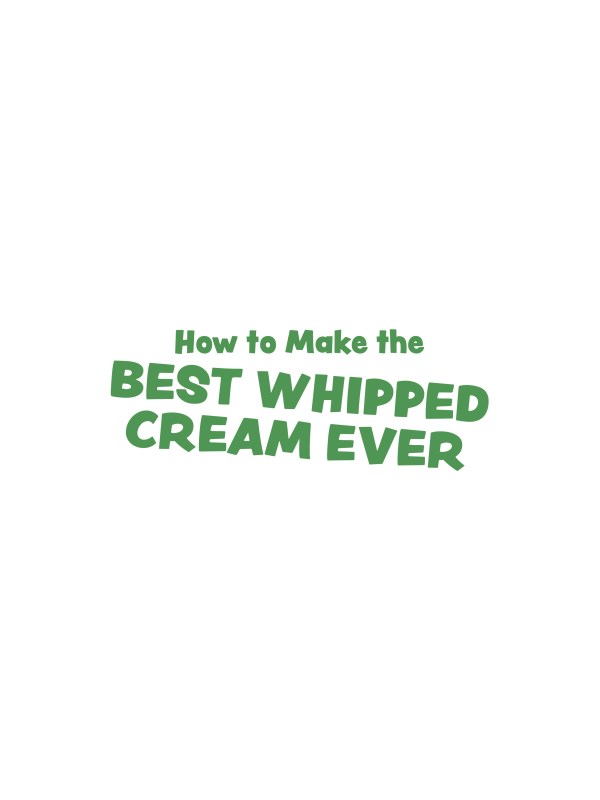

 MAKES About 2 cups whipped cream
MAKES About 2 cups whipped cream
TOTAL TIME 30 minutes
In this experiment, discover the secret to making the lightest, fluffiest whipped cream. You can substitute whipping cream for the heavy cream, but do NOT substitute light cream or half-and-half. An electric mixer will give you the fastest results. You can use a whisk to whip the cream by hand—be prepared for a workout! It will take about twice as long.

Materials
½ cup plus ½ cup cold heavy cream, measured separately
1½ teaspoons plus 1½ teaspoons sugar, measured separately
½ teaspoon plus ½ teaspoon vanilla extract, measured separately
Masking tape or sticky notes
Marker or pen
2 equal-size clear, tall drinking glasses
Liquid measuring cup
Instant-read thermometer (optional)
2 medium bowls
Electric mixer
Rubber spatula
2 spoons per person
 Get Started!
Get Started!
1 Make a prediction: In this experiment, you’ll explore whether the temperature of heavy cream affects the fluffiness of whipped cream. (Heavy cream is the main ingredient in whipped cream.) Which do you predict will make fluffier whipped cream, cold heavy cream or room-temperature heavy cream?
2 Use masking tape and marker to label 1 drinking glass “Room Temperature” and second drinking glass “Cold.” Set aside.
3 Measure ½ cup cold heavy cream, straight from refrigerator. Pour cold heavy cream into medium bowl. (If you have an instant-read thermometer, take the temperature of the heavy cream—it should be about 40 degrees.)
4 Add 1½ teaspoons sugar and ½ teaspoon vanilla to bowl with cold heavy cream. Use electric mixer on medium-low speed to whip cream for about 1 minute. Increase speed to high and whip until cream is smooth and thick, about 1 minute. Stop mixer and lift beaters out of cream. If whipped cream clings to beaters and makes soft peaks that stand up on their own, you’re done! If not, keep beating and check again in 30 seconds.
5 Use rubber spatula to gently scoop whipped cream into drinking glass labeled “Cold.” Use spatula to gently smooth top. Set glass aside.
6 Clean beaters and rubber spatula before you whip second batch of heavy cream.
7 Measure remaining ½ cup heavy cream into liquid measuring cup. Heat in microwave at 50 percent power in 10-second increments for about 20 seconds, or until cream registers about 70 degrees on instant-read thermometer. (If you don’t have an instant-read thermometer, the heavy cream should feel neutral to the touch, neither warm nor cold.)
8 In clean medium bowl, combine room-temperature heavy cream, remaining sugar, and remaining vanilla. Use electric mixer on medium-low speed to whip cream for about 1 minute. Increase speed to high and whip until cream is smooth and thick, about 1 minute. Stop mixer and lift beaters out of cream. If whipped cream clings to beaters and makes soft peaks that stand up on their own, you’re done! If not, keep beating and check again in 30 seconds.
It’s possible that the room-temperature heavy cream will not reach soft peaks, especially if you are using pasteurized heavy cream instead of ultrapasteurized heavy cream. If you’ve whipped the cream for 2 minutes and 30 seconds and it still has not reached soft peaks, stop and continue to step 9.
9 Use rubber spatula to gently scoop whipped cream into drinking glass labeled “Room Temperature.” Use spatula to gently smooth top.
10 Observe your results: Compare your 2 batches of whipped cream:
• Which one fills up more of the drinking glass, the whipped cream made from cold heavy cream or the whipped cream made from room-temperature heavy cream?
• How do your results compare with your preduction?
11 Time for a taste test! Be sure to use a clean spoon for each taste.
• Do the 2 batches of whipped cream taste the same or different?
• Are their textures the same or different? How so?
12 Use your whipped cream to top your favorite desserts, or dollop it on top of fresh fruit.

Want to use your whipped cream a little later?
It will keep in a bowl in the refrigerator for up to 1 hour. If you want to store it for up to 8 hours, spoon the whipped cream into a fine-mesh strainer set over a medium bowl. Place the fine-mesh strainer and bowl in the refrigerator until you’re ready to use the whipped cream. Over time, whipped cream releases liquid. This is called “weeping.” Putting the whipped cream in the fine-mesh strainer lets the liquid drain into the bowl below and keeps your whipped cream fluffy, not watery.

 UNDERSTANDING YOUR RESULTS
UNDERSTANDING YOUR RESULTS
Don’t read until you’ve finished the experiment!
When we tried this experiment in the America’s Test Kitchen Kids lab, the whipped cream made from cold heavy cream was light and fluffy and had nearly twice the volume of the whipped cream made from room-temperature cream. Did your experiment turn out the same way?
Why is temperature so important to making fluffy, cloud-like whipped cream?
First, we have to understand how whipped cream works. Heavy cream is made of 36 to 40 percent fat (the rest is water, protein, sugars, and minerals). The big difference between liquid heavy cream and whipped heavy cream is air—the sugar and vanilla extract add only sweetness and flavor. Whipping heavy cream using an electric mixture or by hand creates lots of tiny air bubbles. The fat in the cream holds the air bubbles in place. As more and more air bubbles form, the heavy cream expands and becomes light and fluffy.
And here’s where temperature comes in: As fat warms up, say from refrigerator temperature (about 40 degrees) to room temperature (about 70 degrees), it gets softer. Think about gently squeezing a stick of butter straight from the fridge versus one you’ve left out for a couple of hours. The room-temperature butter is softer and easier to squeeze, while the cold butter holds its shape.
The warmer, softer fat in the room-temperature heavy cream can’t support the air bubbles very well, so they start to collapse. That means the finished whipped cream won’t have as much volume. The fat in the cold heavy cream is more solid, so it can support more trapped air bubbles—this makes for fluffier whipped cream with more volume.
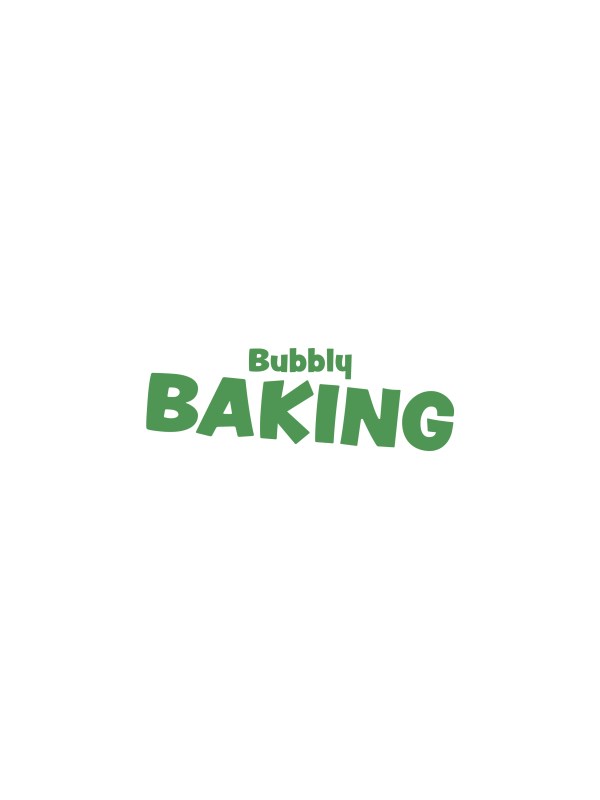

 TOTAL TIME 20 minutes
TOTAL TIME 20 minutes
Baking soda and baking powder are both chemical leaveners—they create bubbly carbon dioxide gas that helps baked goods such as muffins, cakes, and quick breads rise without needing to use yeast. In this experiment, you’ll find out the difference between these two ingredients and learn how they work their bubbly science! Any type of vinegar will work in this experiment.
Materials
1 teaspoon baking powder
1 teaspoon baking soda
¼ cup plus ¼ cup water, measured separately
1 teaspoon vinegar
Masking tape or sticky notes
Marker or pen
2 clear, tall drinking glasses

 Get Started!
Get Started!
1 Use masking tape and marker to label 1 drinking glass “Baking Powder” and second drinking glass “Baking Soda.”
2 Add baking powder to glass labeled “Baking Powder.” Add baking soda to glass labeled “Baking Soda.”
3 Make a prediction: What do you think will happen when you add water to the baking powder and baking soda?
4 Place both glasses in sink. Pour ¼ cup water into each glass.
5 Observe your results: What happened when you added water to each glass? Did you see any bubbles of carbon dioxide gas?
6 Add vinegar to glass labeled “Baking Soda.” Observe what happens. Do you see any bubbles of carbon dioxide gas? What does that tell you about how baking soda works?
 UNDERSTANDING YOUR RESULTS
UNDERSTANDING YOUR RESULTS
Don’t read until you’ve finished the experiment!
Lots of baking recipes call for baking powder, baking soda, or both. When baking soda comes in contact with an acid, such as the vinegar in this experiment, it creates bubbly carbon dioxide gas. In recipes that use baking soda, you’ll almost always see an acidic ingredient, like lemon juice, lime juice, buttermilk, or even yogurt. Baking powder, on the other hand, already contains an acid—and it actually contains baking soda, too. It only needs a liquid (in this experiment, we used water) to start creating carbon dioxide gas.
In recipes for baked goods, such as muffins, quick breads, and cakes, the bubbly carbon dioxide gas causes the batter to rise in the oven, giving the finished product its height and a light, fluffy texture.